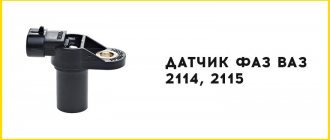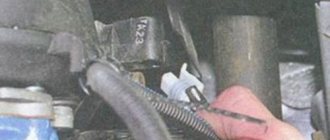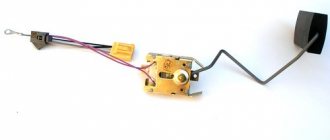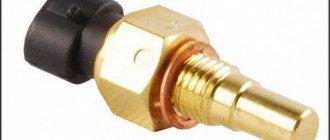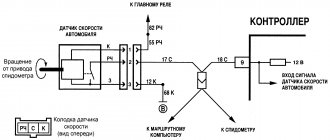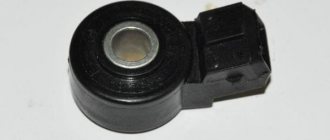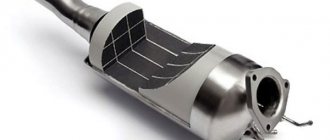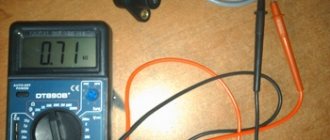Purpose
To control the engine and supply a spark at a certain moment and to the desired cylinder, a crankshaft position sensor is used. It detects the TDC position of the engine and then sends signals to the engine control unit, which sends a signal to the ignition module to supply a spark to the cylinder in which the compression stroke occurs.
The sensor is a rather important element and if it fails, the ECU will not be able to determine which cylinder needs to be supplied with spark and fuel.
Principle of operation
The operating principle of a modern speed sensor (hereinafter DS) is based on the Hall effect:
- The speed sensor transmits voltage pulses to the controller with a frequency directly proportional to the speed of the drive wheels.
- The controller, based on sensor pulses, regulates engine operation in idle mode, and with the help of the IAC (idle speed controller) controls the supply of air bypassing the throttle valve.
- In this case, the frequency of the DS signals is directly proportional to the actual speed of the car.
- DS differ in the connecting connectors to the harness block.
- BOSCH systems use a square connector.
- The sensor, which has a round connector, is used in systems such as GM and January 4.
- All of these sensors are six-pulse; they produce six pulses per axis rotation.
- A ten-pulse sensor is found in Samar carburetor trip computers.
Signals from the speed sensor are used by the control system to calculate fuel shut-off thresholds, and to electronically force limit the speed of the machine (in modern control systems). When installing the speedometer drive in models that still have one in the box, you need to be very careful, otherwise, when misaligned, the fragile plastic teeth on the speedometer drive drive gear will be crushed and then you will have to completely disassemble the entire gearbox (to replace the broken drive) and the cost of the issue increases . The output voltage for a low pulse level is permissible no more than 1 V, and for a high level it must be at least 5 V.
Design
The sensor is a plastic part inside of which there is an electromagnetic element that operates on the Hall effect. A sensitive part protrudes from the sensor, which directly works with the master disk. The VAZ 2115 uses a generator drive pulley as a master disk, which has teeth for determining the position of the crankshaft by a sensor. The sensor is attached to the engine housing through an eyelet, which is pressed against the ebb on the engine using an M6 bolt. The sensor's power supply is shielded; this is necessary so that the signal reaches the control unit without interference.
Construction types
The VAZ 2115 is equipped with two types of crankshaft sensors, which differ in design, but have the same principle of transmitting the read signal. The operation of any controller is based on two components:
- sensing element;
- toothed disc (synchro disc).
The master or synchro disk is installed on the crankshaft and has the same rotation speed with it. The disc rim is divided by 58 teeth, the empty space of two teeth is occupied by the synchronization point. The tracking element is located at a certain distance from the transverse axis of the disk, captures the moment of tooth transition and transmits the number of crankshaft revolutions to the computer.
According to the type of design, the sensors on the VAZ 2115 can be of the inductive type and based on the Hall effect. Optical sensors that use a light beam are rarely installed on cars, since the engine compartment is often highly dusty. There is a danger that the sensitive element of the light catcher will be clogged with grease, oil, etc.
The magnetic controller for VAZ is based on a core with a winding installed in a plastic case. The principle of signal transmission is based on the law of electromagnetic induction. On the winding of the core, when a part of the disk without a tooth passes next to it, there is no current; when a part of the disk with a tooth approaches, a magnetic field arises, the winding is excited, current induction appears, and a stable electrical signal is formed, which is transmitted to the ECU.
The advantages of the magnetic sensor are obvious: its operation does not require power from the on-board network. Accordingly, the risk of breakdowns is reduced; during diagnostics, only the condition of the winding, core and signal quality to the ECU are checked.
DPKV, the operating principle of which is based on the Hall effect, requires connection to the on-board network. The operation is based on the occurrence of voltage on two plates through which current passes.
The cost of controllers for the entire VAZ line starts from 200 rubles, so parts are not repaired, only replaced.
Symptoms of a problem
The crankshaft sensor has several characteristic signs of failure that clearly indicate its malfunction, but at the same time there are also signs that can be confused with other parts of the car engine.
If the DPKV is faulty, the car will show the following signs of breakdown:
- There is no spark;
- The engine does not start;
- One of the cylinders does not work;
- The car jerks when driving;
- Poor dynamics;
- Loss of power;
- Increased fuel consumption;
- The engine starts and immediately stalls;
- Doesn't start hot;
If there is no spark on the engine, this indicates a malfunction in the DPKV.
Dismantling and installation
So, you have determined that the DPKV has failed. Therefore, there is nothing left to do but replace it. To do this you will have to dismantle the old device.
- Turn off the ignition and open the hood. Securely secure it to avoid unpleasant blows to the back or head.
- Remove any dirt from around the sensor so that it can be removed and visually inspected.
- Disconnect the wiring block from the corresponding connector.
- Using a 10 mm wrench, you can easily remove the crankshaft sensor mount.
- Remove the damaged device.
- At the same time, be sure to check the generator drive timing pulley. It is not uncommon for damage to appear on it, due to which the device cannot operate correctly. These teeth cause error codes to appear on the on-board computer.
- If there are no defects and nothing prevents the installation of a new device, begin assembly.
- If necessary, clean the installation site of the DPKV.
- Place the new measuring device in the socket and tighten the mounting bolt. In this case, do not exceed a tightening torque of more than 12 N m.
- Be sure to use the adjusting washer, which is already supplied by responsible sensor manufacturers.
- Using a special feeler gauge, make sure that there is a gap of 1 millimeter between the pulley and the DPKV core.
- The gap error can be no more than 0.41 millimeters in the upward direction. Under no circumstances should the gap be less than the required 1 mm.
Maintain clearance
Price issue
As we have already noted, VAZ 2114 owners are not often faced with the need to change the DPKV. But always be prepared for such troubles.
You don’t have to spend a lot of money purchasing a new sensor. The price depends on the store and region where car parts are sold. On average, a recreation center costs about 200-400 rubles.
Replacement at a service station is still a cost around the cost of several sensors. Therefore, think about who exactly will do the work - you or the car service specialists.
Examination
You can check the DPKV using diagnostic equipment using the ADC and multimeter channels. As a diagnostic device, you can use the ELM327 with the OpenDiag smartphone application; this assembly of the device and application allows you to determine faults in the car quite simply and is in no way inferior to professional diagnostic equipment.
Checking with a multimeter
Testing with this method consists of measuring the resistance of the inductor, which is located inside the sensor; most often it is the cause of sensor failure.
To carry out the check you must:
- Set the resistance measurement limit on the multimeter to 2 kOhm;
- Next, connect the multimeter probes to the terminals on the sensor;
- The readings on the multimeter should be in the range from 500 to 800 Ohms, if the readings agree, then the sensor is working;
- If the readings have a different range or the tester even shows 1, then this indicates a break in the inductor inside the sensor;
- In case of such a breakdown, the sensor must be replaced with a new one;
How to independently replace the crankshaft sensor on a VAZ 2115 car
Required materials and tools:
- wrench “10”, socket, wrench, flat-tip screwdriver;
- rags, additional lighting as needed;
- new DPKV.
Step-by-step DIY replacement guide:
- we place the car on the inspection channel, secure the wheels with wheel chocks, and squeeze the parking brake;
- in the area where the oil pump is located, use a screwdriver to pry up the block with terminals, remove it, and move the power contacts to the side;
- Unscrew the screw (to “10”) – the sensor lock;
- we remove the controller, carry out troubleshooting, wipe it, clean the seat from any remaining dust and dirt;
- insert the new controller, screw it on, and assemble the structure in reverse order.
DIY replacement completed.
Replacement
To independently replace the DPKV on a VAZ 2115, you do not need to have great skills in car repair. You just need to prepare the necessary tools.
To replace you will need:
- Pliers;
- 10 mm wrench;
Replacement process
It is most convenient to carry out work from an inspection hole or overpass, but if one is not available, you can remove the right front wheel and unscrew the engine mudguard, after which free access to the sensor will open.
- Remove the connector from the sensor;
- Unscrew the bolt with a 10mm wrench;
- Quite often, the sensor turns sour in its seat, after which it is difficult to get it out of there; to do this, you can use pliers and rotate the sensor to remove it;
- Before installing a new sensor, you need to clean the seat for easier installation;
- We assemble in the reverse order;
Location
The crankshaft position sensor (CPS) on the VAZ 2115 is located on the oil pump housing, namely, it has a special casting in the form of a bracket into which the sensor is installed and fixed in its position with a bolt. You can see the sensor by looking closer to the oil filter or from the inspection hole.
| Name / catalog item | Price in rubles |
| Injector 351.3847 ROMB | From 170 – 200 |
| 402.3837 AutoTrade | From 170 – 200 |
| 191.3847 (8 valves) | From 170 – 200 |
| 2112-3847010-04 | From 170 – 200 |
| EMZ 'Pegasus' 191.3847 | From 170 – 200 |
| Astro 27.3847 (8 valves) | From 170 – 200 |
| StartVolt VS-CS 0112 | From 170 – 200 |
| CTR Cartronic 2112-3847010-04 | From 170 – 200 |
| RepCom RK02004 (8 valves) | From 170 – 200 |
| Schetmash 2112-3847010 (8 valves) | From 170 – 200 |
Crankshaft sensor functions
As already mentioned, one of the obvious signs of DPKV problems is a complete engine stop. This happens as a result of the fact that malfunctions in its operation do not allow the power system to supply fuel in a timely manner, and the ignition system is not capable of igniting the fuel-air mixture at a given moment. Now let's look at why this happens.
The crankshaft sensor sends signals to the ECU indicating the position of the crankshaft at a certain moment, and also reports the direction of rotation of the shaft and indicates the rotation speed. Please note that on different cars, both the device itself and some functions of the DPKV may differ. This depends on the type of element installed. Devices can be:
Sensor overview
What the controller is responsible for:
- Fuel injection phase synchronization;
- Timely supply of an impulse to ignite the fuel in the cavity of the combustion chamber.
The serviceability of the controller determines the timeliness and completeness of supply of the fuel mixture to the cylinders and combustion chamber.
The angle of inclination of the teeth is 6°. During the passage of each of them, the sensor counts the quantity and sends the data to the electronic control unit of the ECU.
The ECU analyzes the received data, reduces or increases the crankshaft speed in order to maintain the ignition timing within the permissible range.
The crankshaft teeth are equidistant from each other. The last two teeth are removed from centering the pulley at the top dead center (TDC) position.
Where is the controller located: on the oil pump cover in the engine compartment. Access to equipment for preventive maintenance from under the bottom of the machine.
Note to the driver. Some motorists practice installing a sensor from a VAZ 2107 due to its low cost. The automaker strongly recommends purchasing and installing original parts with factory catalog numbers. External similarity and identity of parts does not guarantee full functionality.
Signs of a faulty crankshaft sensor:
- The engine does not start;
- Starting the engine is difficult;
- Idle speed is unstable;
- Sudden drop in engine power;
- Detonation;
- Passive acceleration dynamics;
- Increased fuel consumption;
- Under light loads, systematic shifts to a lower range of gears.
These symptoms are signs of a number of other malfunctions. Carry out comprehensive diagnostics using digital equipment for data objectivity.
| Name / catalog item | Price in rubles |
| Injector 351.3847 ROMB | From 170 – 200 |
| 402.3837 AutoTrade | From 170 – 200 |
| 191.3847 (8 valves) | From 170 – 200 |
| 2112-3847010-04 | From 170 – 200 |
| EMZ 'Pegasus' 191.3847 | From 170 – 200 |
| Astro 27.3847 (8 valves) | From 170 – 200 |
| StartVolt VS-CS 0112 | From 170 – 200 |
| CTR Cartronic 2112-3847010-04 | From 170 – 200 |
| RepCom RK02004 (8 valves) | From 170 – 200 |
| Schetmash 2112-3847010 (8 valves) | From 170 – 200 |
Technical characteristics of DPKV:
- Winding resistance range: 570 – 750 Ohm;
- Winding inductance: 250 MHz;
- Minimum sensor voltage amplitude: 0.3V;
- Maximum sensor voltage amplitude: 225V;
- Dimensions: 30x45x69 mm;
- Weight: 52 grams.
Step-by-step instructions for self-diagnosis
To check the DPKV you will need a multimeter.
- We dismantle the metal protection of the oil pan, provided that it is installed. Fastening with six screws around the perimeter.
- From under the bottom of the car, disconnect the terminals from the sensor.
- We bring the limit switches of the multimeter to the contacts;
- Turn on the multimeter, set the position of the regulator to “resistance”;
- We carry out actual measurements;
- We compare the obtained data with standards. If the arrow tends to infinity, the controller is working. If it goes to “zero”, it’s a breakdown. Average readings are 550-750 Ohms.
Depending on the diagnostic results, the technician makes a decision on the advisability of further operation of the equipment.
Causes of premature wear of the DPKV
- long-term operation without prevention;
- manufacturing defects;
- third-party mechanical damage;
- getting sand, dirt, or metal shavings inside the controller;
- sensor breakage due to crankshaft teeth;
- damage to the DPKV during repair work;
- short circuit in the on-board circuit.



